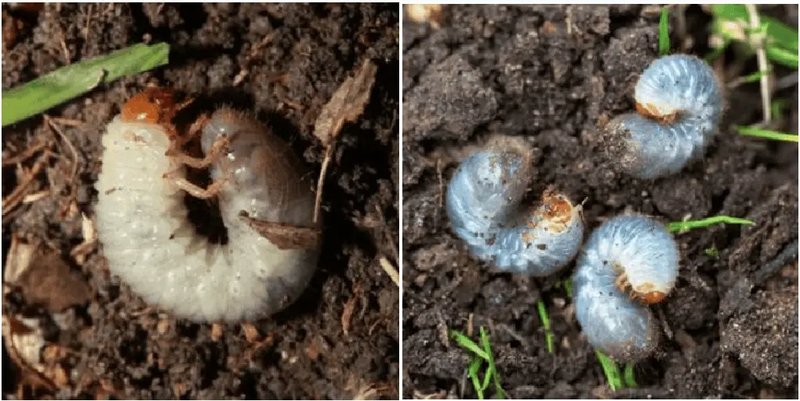
Imagine you’ve just planted a beautiful flower in a pot, only to find it wilting away a few days later. You water it, give it sunlight, and nurture it, but it still struggles. That’s when the mystery begins—could it be **grub worms**? In this article, we’ll dig into how these pests can affect your plants, how to identify them, and what steps you can take to protect your green friends.
What Are Grub Worms?
Grub worms are the larval stage of various beetles, such as Japanese beetles and June bugs. At first glance, they look like small white worms with curled bodies, usually found in the soil. They thrive in warm, moist environments, making your potted outdoor plants a prime target.
You might be wondering how these little guys fit into the bigger picture. Think of them as the teenage troublemakers of the insect world. Their diet primarily consists of plant roots, which is bad news for your potted plants. They feed on the roots, which provide essential nutrients and water. Without strong roots, your plant’s ability to survive and grow diminishes significantly.
How Grub Worms Damage Your Plants
The damage caused by grub worms can often go unnoticed until it’s too late. As they munch on the roots, several symptoms can arise. Here’s what to look out for:
- Wilting leaves: If you notice your potted plants drooping despite regular watering, that’s a red flag.
- Yellowing foliage: Healthy plants have vibrant green leaves. If they start to turn yellow, it could indicate root damage.
- Stunted growth: A plant that isn’t growing as expected may be struggling underground because of grub worm activity.
Seeing these signs can be frustrating. You’ve invested time and care into your plants, only to have them undermined by pesky insects. The roots are the lifelines; when they’re compromised, the entire plant suffers.
How to Identify Grub Worm Infestation
Identifying a grub worm infestation doesn’t require a degree in entomology—just a little observation and digging. Here’s a simple step-by-step approach:
1. **Inspect the Soil:** Gently lift the plant from its pot and check the soil. Look for small, white, C-shaped larvae. They’re usually about 1 inch long and can be found wriggling around.
2. **Check for Holes:** Look for tiny holes in the soil surface. These can be signs of adult beetle activity, and where there are adults, there are likely grubs nearby as well.
3. **Observe Plant Health:** As mentioned earlier, if your plant is wilting or yellowing with no other apparent cause, it could be the result of grub worms.
Identifying these pests early can help you take the necessary steps to protect your plants before the situation worsens.
Preventive Measures Against Grub Worms
Prevention is always better than cure, right? Here’s how you can keep grub worms at bay:
- Healthy Soil: Start with nutrient-rich, well-draining soil. Poor soil conditions can attract grubs.
- Regular Monitoring: Keep a close eye on your plants, especially in the warmer months when grubs tend to thrive.
- Beneficial Nematodes: These microscopic worms are natural predators of grub worms. Introducing them to your soil can help keep grub populations in check.
Think about it like maintaining a healthy lifestyle. Just as we eat nutritious food and exercise to keep ourselves healthy, our plants need the right conditions to thrive. Regular monitoring and care can help catch issues before they spiral.
Treatment Options for Infested Plants
If you’ve found grub worms in your potted plants, don’t panic! Here are some treatment options to consider:
1. **Manual Removal:** If the infestation is small, you can simply remove the grubs by hand. Just be sure to wear gloves!
2. **Insecticidal Soaps:** These can be effective against young grubs. Follow the instructions carefully, and apply it directly to the soil.
3. **Diatomaceous Earth:** This natural powder can deter grubs when sprinkled on the soil. It’s harmless to beneficial insects but can damage soft-bodied pests.
Each treatment option has its pros and cons, so consider what fits best with your gardening style and philosophy. Remember, the goal is to protect your plants while being mindful of the environment.
Long-Term Care for Potted Plants
Caring for potted outdoor plants goes beyond fighting off pests. Here are some best practices to ensure your plants remain healthy and strong:
- Regular Watering: Ensure you water your plants properly. Deep watering encourages strong root systems.
- Fertilizing: Use organic fertilizers to keep your plants nourished. This makes them less attractive to pests.
- Rotate Your Plants: Changing the location of your pots can disrupt any pest life cycles that may be taking root.
Maintaining healthy potted plants is like nurturing a friendship—it takes effort, time, and a little love. The more care you give, the stronger they become.
Understanding how **grub worms** affect potted outdoor plants is essential for any gardener. These little pests can cause significant damage to your plants, but with proper identification and preventive measures, you can keep them from wreaking havoc in your garden. By being proactive and attentive, you’ll ensure that your plants stay beautiful and healthy. It’s all about creating a thriving, harmonious environment—one where both you and your plants can flourish together!
So, the next time you notice your plants looking a little worse for wear, remember to take a closer look at the roots. You might just uncover a hidden party of grub worms, and now you’ll know how to handle them!
